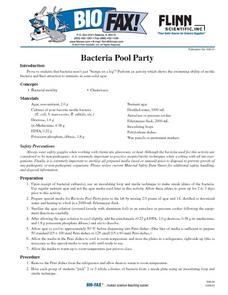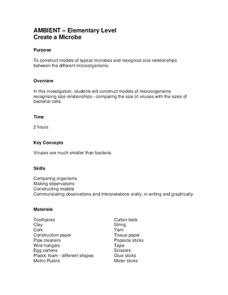Curated OER
Micro-organisms
Students discuss micro-organisms. In this micro-organisms lesson, students identify which micro-organisms are harmful and which ones are beneficial. Students complete a worksheet which is included in the lesson.
Study Stack
Micro Crossword Puzzle
For this online interactive science crossword puzzle learning exercise, students use the 8 clues regarding bacteria to find the appropriate answers to complete the word puzzle.
Curated OER
The Structure of DNA
In this the structure of DNA instructional activity, students read a passage about the structure of DNA in bacteria and then relate that information to answer the questions given.
Curated OER
Simulation of Irradiation
In this irradiation worksheet, students simulate the effects of irradiation on bacteria growth by using UV light. Then students complete 6 short answer questions.
Curated OER
Viruses and Bacteria
Reviewing the key terms and ideas from a chapter about viruses and bacteria, this activity helps students to reinforce their knowledge about the makeup and life cycle of a virus. Students answer true/false questions, blanks from a word...
Curated OER
Viruses and Simple Organisms
In this simple organisms worksheet, students review the characteristics of bacteria, viruses, parasites, monerans, and protists. This worksheet has seven matching, five true or false, five multiple choice, and four short answer questions.
Curated OER
Classifying Life
In this classifying life worksheet, students review the 5 kingdoms of organisms by completing 10 matching and 7 fill in the blank questions.
Curated OER
Defense Against Infectious Diseases
In this infectious disease defense worksheet, students will review the immune system including acquired, antibody, and cellular immunity. Students will then compare passive and active immunity to infectious diseases. This worksheet has...
Curated OER
Viruses
In this virus worksheet, 9th graders study the graph shown that illustrates the sizes of viruses, bacteria, and other structures. Then they state how large a red blood cell is and how large the smallest viruses are that affect plants....
Curated OER
Two Kingdoms of Bacteria
For this bacterial growth worksheet, students conduct an experiment on how temperature affects bacterial growth between a jar placed in the refrigerator and another in a warm place. They also describe what they would infer was the...
Curated OER
Two Kingdoms of Bacteria
For this bacterial growth worksheet, 9th graders name and describe the three types of bacteria found. Then they label the figure of the bacterium by writing the correct term next to each number. Students also describe the difference...
Curated OER
Bacteria in Your Life
In this bacteria learning exercise, students conduct an experiment by looking through their cupboard and refrigerator at home and locating the expiration date on six foods. Then they record what they found in the table shown. Students...
Curated OER
Bacteria in Your Life
In this bacteria activity, students describe the process that kills harmful bacteria in milk. Then they describe what types of bacteria are helpful to farmers and which two plants have these bacteria in their roots. Students also name...
Curated OER
Cells: The Units of Life
In this biology worksheet on cells, 9th graders name who the first person was to use the word cell and describe in what materials this person saw cells. Then they determine what instrument uses light and two or more lenses to view cells.
Curated OER
Your Immune System
In this immune system worksheet, students describe an antibody and how it functions. Then they determine sources of passive immunity and how HIV affects the immune system. Students also name defenses that the digestive system has against...
Curated OER
Isolating Bacteria from a Mix Culture
Students isolate three species of bacteria using the plate streak method, implement sterile microbiology techniques, and produce pure cultures of each microorganism at the end of this exercise. They write a descriptive paragraph for each...
Curated OER
Outbreak!
Students study and research drug-resistant bacteria and the use of antibiotics. Through the use of the internet, and other resources, students gather information and create a board game. They discuss bacteria, antibodies, antibiotics...
Curated OER
Health: Food Borne Illnesses
Students discover how to inhibit food borne illnesses by practicing safe food-handling techniques. Among topics they examine are the advantages and disadvantages of using wooden or plastic cutting boards. After studying for the test,...
Curated OER
And the Bacteria Ran Away with the Petri Dish
Sixth graders complete a think, pair, share activity on an antibiotic overhead. In groups, they participate in an exercise in which they can see how germs behave and how they are treated. To end the lesson, they discuss how a...
Curated OER
Diseases
Sixth graders create a type of notebook or journal using colored copy paper on which to take notes. They complete research on a certain disease and report on it and then design their own disease causing bacteria or virus. Finally, 6th...
Curated OER
THE FARMER CARES FOR THE LAND
Students will identify cause and effect relationships in issues relating to Agriculture and the environment.Ask students to describe what farmers do. Then ask students to define the word "environmentalist." Ask students if they have...
Curated OER
Bacteria Pool Party
Students investigate the organisms of bacteria. They are given a culture of bacteria that can be observed under a microscope. The students make observations that are recorded. The lesson includes the mention of specific safety...
Curated OER
Create a microbe
Young scholars explore viruses and bacteria. They construct three dimensional models of microorganisms recognizing size relationships by comparing the size of viruses with the sizes of bacterial cells.
Curated OER
Viewing Bateria
Students use microscopes to observe E. coli bacateria on prepared slides and in a live culture. They use micro-slide viewers to observe the shapes of various bacteria and the structures within the bacterial cell. Students make an...

























